Llamaslikesciencetoo - This Is My Side Blog About Science
More Posts from Llamaslikesciencetoo and Others

x
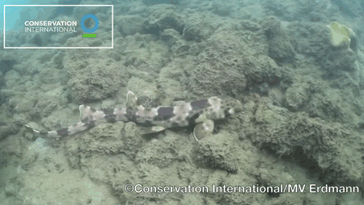
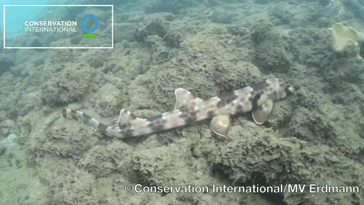
The epaulette shark (Hemiscyllium ocellatum) is a small species of longtailed carpet shark found in shallow, tropical waters (typically coral reefs or in tidal pools). The common name of this shark comes from the very large, white-margined black spot behind each pectoral fin, which are reminiscent of military epaulettes. Something unique (and adorable!) about these sharks is that rather than swimming, sometimes they “walk” by wriggling their bodies and pushing with their paired fins.

Mildred Dresselhaus, a professor emerita at the Massachusetts Institute of Technology whose research into the fundamental properties of carbon helped transform it into the superstar of modern materials science and the nanotechnology industry, died on Monday in Cambridge, Mass. She was 86.
Her death, at Mount Auburn Hospital, was confirmed by her granddaughter Leora Cooper. No cause was given.
Nicknamed the Queen of Carbon in scientific circles, Dr. Dresselhaus was renowned for her efforts to promote the cause of women in science. She was the first woman to secure a full professorship at M.I.T., in 1968, and she worked vigorously to ensure that she would not be the last.
In 1971, she and a colleague organized the first Women’s Forum at M.I.T. to explore the roles of women in science. Two years later she won a Carnegie Foundation grant to further that cause.
“I met Millie on my interview for a faculty job in 1984,” said Lorna Gibson, now a professor of materials science and engineering. “M.I.T. was quite intimidating then for a new female, but Millie made it all seem possible, even effortless. I knew it wouldn’t be, but she was such an approachable intellectual powerhouse, she made it seem that way.”
[…]
Dr. Dresselhaus used resonant magnetic fields and lasers to map out the electronic energy structure of carbon. She investigated the traits that emerge when carbon is interwoven with other materials: Stitch in some alkali metals, for example, and carbon can become a superconductor, in which an electric current meets virtually no resistance.
Dr. Dresselhaus was a pioneer in research on fullerenes, also called buckyballs: soccer-ball-shaped cages of carbon atoms that can be used as drug delivery devices, lubricants, filters and catalysts.
She conceived the idea of rolling a single-layer sheet of carbon atoms into a hollow tube, a notion eventually realized as the nanotube — a versatile structure with the strength of steel but just one ten-thousandth the width of a human hair.
She worked on carbon ribbons, semiconductors, nonplanar monolayers of molybdenum sulfide, and the scattering and vibrational effects of tiny particles introduced into ultrathin wires.
She published more than 1,700 scientific papers, co-wrote eight books and gathered a stack of accolades as fat as a nanotube is fine.
Dr. Dresselhaus was awarded the National Medal of Science, the Presidential Medal of Freedom (bestowed by President Barack Obama), the Kavli Prize in Nanoscience, the Enrico Fermi prize and dozens of honorary doctorates. She also served as president of the American Physical Society and the American Association for the Advancement of Science and worked in the Department of Energy in the Clinton administration.
Continue Reading.
Amazing, this is a crinoid swimming (edited after comments)

Plate 12. Jellies. Histoire naturelle des zoophytes. Acalèphes. 1843.
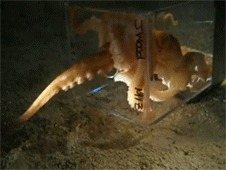
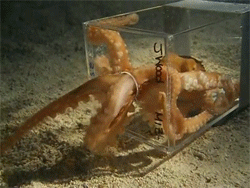




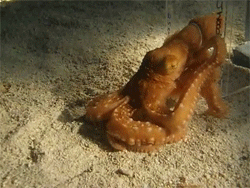
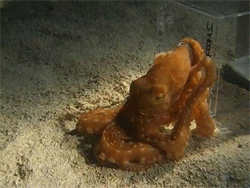


KELP FOREST REPLACE CORALS IN THE MEDITERRANEAN
A decrease from pH 8.1 to 7.9 observed in a CO2 vent system at 40 m depth leads to a dramatic shift in highly diverse and structurally complex habitats.
Rising levels of CO2 released by anthropogenic activities are driving unprecedented changes in the chemistry of the oceans. The mean ocean surface acidity has increased by 25–30% (equivalent to a drop of 0.1 pH units) since as the advent of the Industrial Revolution in the 1780s and is predicted to decline by a further 150–200% by the end of the century.
Ocean acidification is one of the greatest long-term challenges facing the survival of reefs and coral. Habitats widely distributed in the Mediterranean, such as coral colonies and maerl environments, characterized by the predominance of calcareous organisms, are relegated by Laminaria rodriguezii forests.
Dominant habitats at mesophotic depths (the deepest part of the photic zone where light penetration is low, typically from 30–40 m to over 150 m) are usually characterized by a large dominance of calcifying organisms, such as endangered coralligenous outcrops and rhodolith beds in the Mediterranean Sea, which display a notable carbonate production. Calcareous red algae are the main framework builders in those two habitats, providing structural complexity and favouring biodiversity
Reference: Linares et al. 2015. Persistent natural acidification drives major distribution shifts in marine benthic ecosystems. Proc. R. Soc. B



a dream come true: ORCAS IN THEIR NATURAL HABITAT!
they examined our cruise vessel inquisitively and played in our stern wave <3 to watch these gentle giants from up close was such a beautiful once in a lifetime experience! they stayed quite a while so i could enjoy the moment and still take some neat pics. thank you for this special day, guys! stay safe.


The Mud Dragons of Calvert Island, BC
Shedding light on these mysterious marine creatures.
by Josh Silberg
Spiky headed dragons roam the ocean floor from the poles to the tropics. But these are not winged beasts from the pages of science fiction. These strange creatures are Kinorynchs, aka “mud dragons“, and they are very real.
Roughly the size of a grain of salt, mud dragons are often overlooked, but a team from the Hakai Institute and the University of British Columbia (UBC) hopes to give them the spotlight they deserve.
“Canada has very few reports on these animals. The first step is to know what is there,” says Dr. Maria Herranz, a Hakai post-doctoral scholar and resident mud dragon expert at UBC…
(read more and see video: Hakai)
images by Marria Harranz

Updated visalization of every Vaquita left on Earth
There are supposed to be 5000 of them. Now there are 30.
What has been done so far has not worked, including the ban on gill nets, and the capture effort that is coming will probably be far too late.
This is humanity’s fault.
China for pushing the market for totoaba swim bladders, Mexico for allowing it until this point, and the rest of us for not stepping up until they are at death’s door.
This species will most likely be gone in one or two years, and it will be the second cetacean species to die out in a little over ten years, the second in the entire 200 000 year history of the human species.
-
 decorbuziers-memorial liked this · 1 year ago
decorbuziers-memorial liked this · 1 year ago -
 passafrisk liked this · 1 year ago
passafrisk liked this · 1 year ago -
 traitorcas liked this · 1 year ago
traitorcas liked this · 1 year ago -
 trafmannoticge liked this · 1 year ago
trafmannoticge liked this · 1 year ago -
 f4ll0ut-k1nd3r reblogged this · 1 year ago
f4ll0ut-k1nd3r reblogged this · 1 year ago -
 generalhvwth0rn3 liked this · 1 year ago
generalhvwth0rn3 liked this · 1 year ago -
 merridelicious reblogged this · 1 year ago
merridelicious reblogged this · 1 year ago -
 merridelicious liked this · 1 year ago
merridelicious liked this · 1 year ago -
 psychuan reblogged this · 1 year ago
psychuan reblogged this · 1 year ago -
 psychuan liked this · 1 year ago
psychuan liked this · 1 year ago -
 shrimply-pebbles reblogged this · 2 years ago
shrimply-pebbles reblogged this · 2 years ago -
 shrimply-pebbles liked this · 2 years ago
shrimply-pebbles liked this · 2 years ago -
 bikerfish liked this · 2 years ago
bikerfish liked this · 2 years ago -
 warriorocteivia liked this · 2 years ago
warriorocteivia liked this · 2 years ago -
 sircrowley liked this · 2 years ago
sircrowley liked this · 2 years ago -
 starlight-vee liked this · 2 years ago
starlight-vee liked this · 2 years ago -
 sissyslut-666 liked this · 2 years ago
sissyslut-666 liked this · 2 years ago -
 lorddarkday reblogged this · 2 years ago
lorddarkday reblogged this · 2 years ago -
 lorddarkday liked this · 2 years ago
lorddarkday liked this · 2 years ago -
 thevoiceofmadness liked this · 2 years ago
thevoiceofmadness liked this · 2 years ago -
 drderk reblogged this · 2 years ago
drderk reblogged this · 2 years ago -
 general-jazz liked this · 3 years ago
general-jazz liked this · 3 years ago -
 oiworker liked this · 3 years ago
oiworker liked this · 3 years ago -
 babushkats reblogged this · 3 years ago
babushkats reblogged this · 3 years ago -
 decadentbouquetstudent liked this · 3 years ago
decadentbouquetstudent liked this · 3 years ago -
 yesitsanusha reblogged this · 3 years ago
yesitsanusha reblogged this · 3 years ago -
 saraayusuf reblogged this · 3 years ago
saraayusuf reblogged this · 3 years ago -
 ironsaladcalzoneeclipse liked this · 3 years ago
ironsaladcalzoneeclipse liked this · 3 years ago -
 violet-jessop liked this · 3 years ago
violet-jessop liked this · 3 years ago -
 num-numsthings liked this · 3 years ago
num-numsthings liked this · 3 years ago -
 pachucocholosychundos reblogged this · 3 years ago
pachucocholosychundos reblogged this · 3 years ago -
 pachucocholosychundos liked this · 3 years ago
pachucocholosychundos liked this · 3 years ago -
 mike0420 liked this · 3 years ago
mike0420 liked this · 3 years ago -
 yellowraddie reblogged this · 3 years ago
yellowraddie reblogged this · 3 years ago -
 send-your-playlist reblogged this · 3 years ago
send-your-playlist reblogged this · 3 years ago -
 send-your-playlist liked this · 3 years ago
send-your-playlist liked this · 3 years ago -
 doriansapprentice reblogged this · 3 years ago
doriansapprentice reblogged this · 3 years ago -
 doriansapprentice liked this · 3 years ago
doriansapprentice liked this · 3 years ago
Mainly interested in ecology, but also the entirety of science.
179 posts